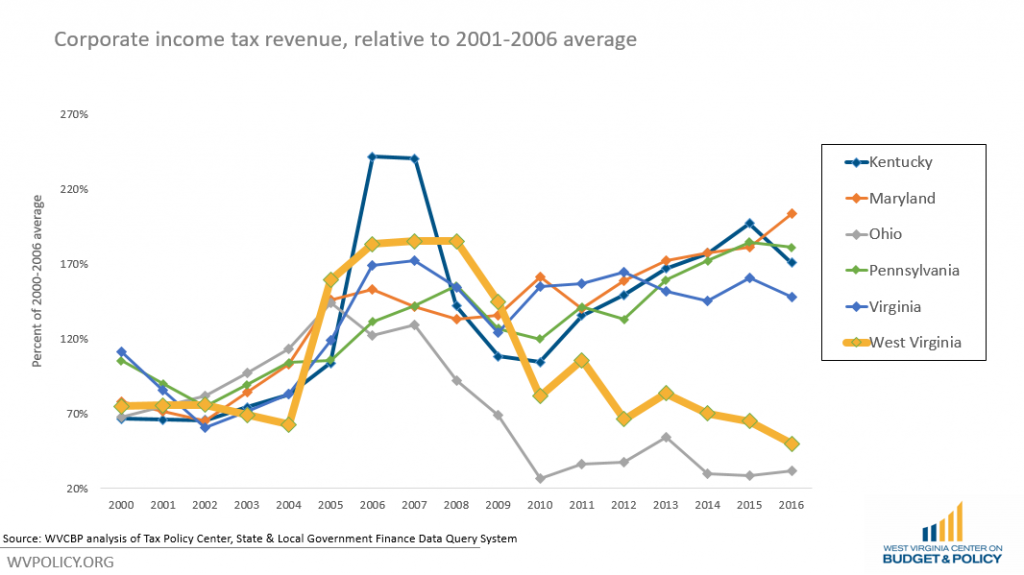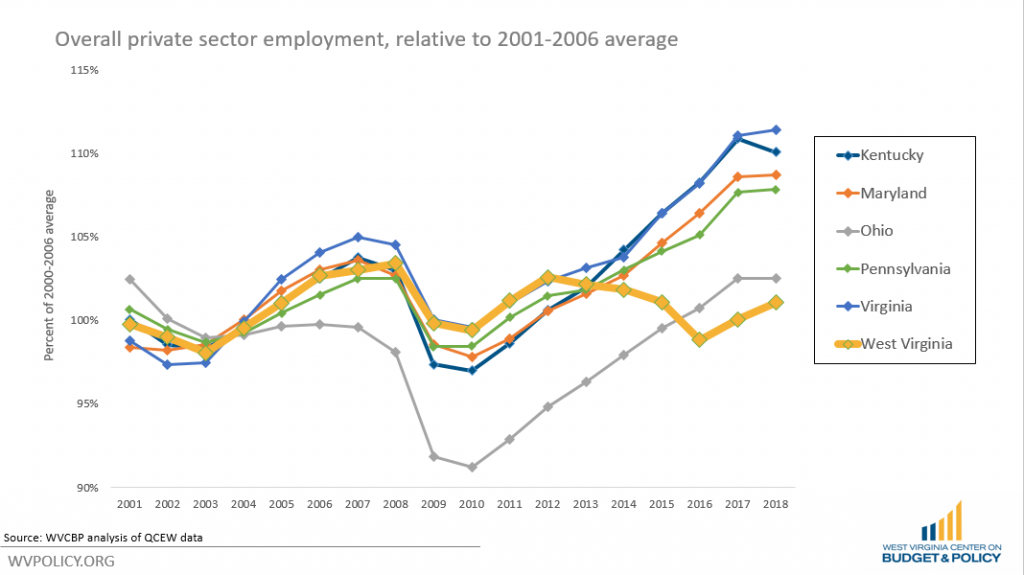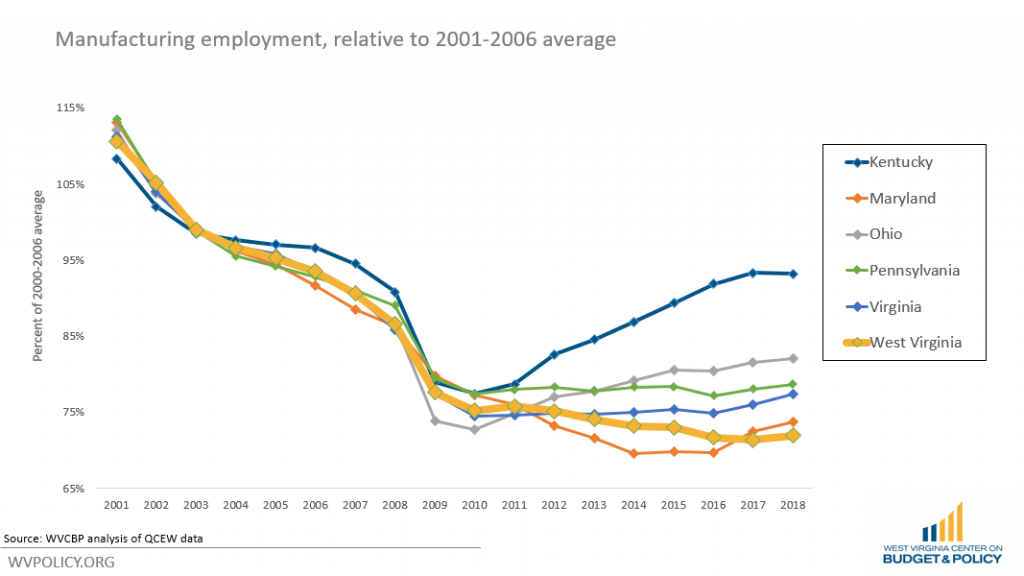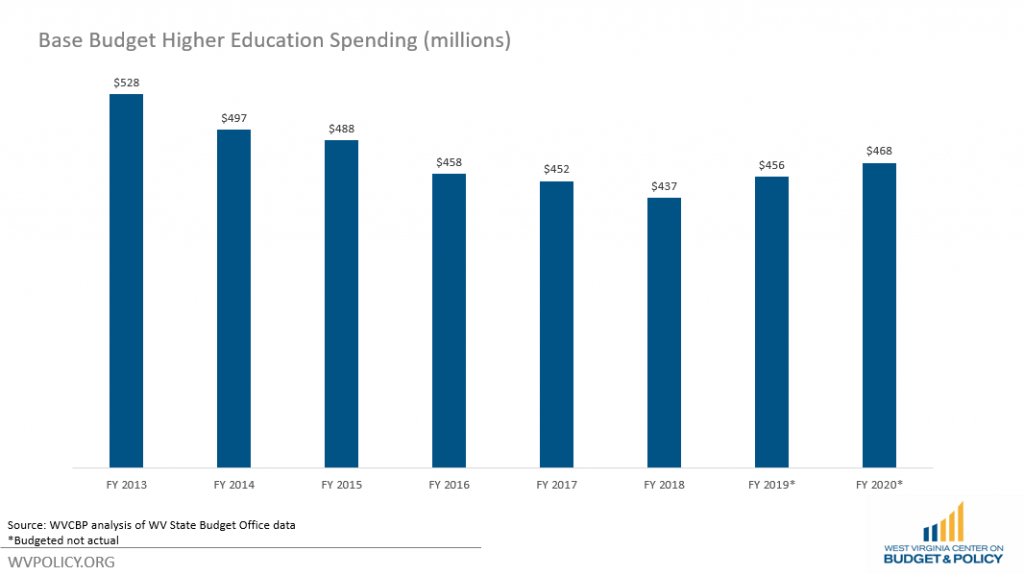It has been 12 years since West Virginia began its tax cut experiment, phasing out the business franchise tax and cutting the corporate net income tax rate from 9% to 6.5%, and nearly 5 years since the cuts have been fully in place. While we’ve explored before why business tax cuts aren’t likely to work when it comes to creating jobs, enough time has passed since West Virginia’s tax cuts to evaluate how effective the tax cuts were. And the results are not pretty.
Tax cut enthusiasts like the Tax Foundation said that West Virginia’s tax cuts would put the state “in a better position to compete regionally with Pennsylvania and Virginia and place itself in a better position nationally“ while the conservative Cato Institute said the West Virginia had enacted the “most pro-growth tax reform” in the country.
So how has the most pro-growth tax reform helped West Virginia compete regionally? First, lets take a look at business tax revenue. The chart below compares business tax revenue growth relative to the 2000-2006 average (before the tax cuts were started) between West Virginia and the neighboring states. And as the chart shows, West Virginia experienced a significant decline in business tax revenue as the tax cuts took affect. Before the tax cuts West Virginia’s tax revenue was 85 percent higher than the 2000-2006 average. While all of the neighboring states saw a decline in revenue during the recession, West Virginia’s revenue has continued to fall, and by 2016 was less than half the pre-tax cut average. Meanwhile the other state’s have seen revenues rebound in recent years. The exception is Ohio, which like West Virginia, enacted a series of business tax cuts during roughly the same time period.

Looking at total private sector job growth, there is no indication that West Virginia’s business tax cuts had an effect. West Virginia’s neighboring states all share the same pattern of job growth, declining during the recession, than recovering and growing in the years since, with Ohio experiencing a sharper decline, and lower growth overall. West Virginia showed no noticeable impact from its tax cuts, and in fact, has seen slower overall job growth for the past several years, despite the tax cuts being fully in effect. The tax cuts have not put West Virginia “in a better position to compete regionally” as promised. Instead, the state has under-performed since the tax cuts were enacted. Interestingly enough, the next worse performing state, Ohio, was the state that also enacted a series of major business tax cuts.
Before the tax cuts went into effect, West Virginia’s private sector employment was roughly 3 percent higher than the 2000-2006 average. Since then employment has fallen, and private sector employment in 2018 was equal to the pre-tax cut average.

Taking a look at manufacturing employment tells largely the same story. Manufacturing employment in West Virginia and its neighboring state had been declining for a number years before the recession. That decline accelerated during the recession, and then had since leveled off, with the exception of Kentucky, where its has begun to grow. There is no noticeable impact of the tax cuts on West Virginia’s manufacturing employment, and West Virginia has again, had the worst performance of its neighboring states since the tax cuts were enacted. In 2018, manufacturing employment was 28 percent lower in West Virginia than the pre-tax cut average.

Instead of creating jobs and economic growth, West Virginia’s tax cuts led to large annual revenue losses, forcing the state to make painful budget cuts. In particular, higher education was a target for cuts. Between FY 2013 and FY 2017, West Virginia cut $91 million from higher education, as revenue losses mounted. Falling public support for the state’s universities and colleges has led to tuition rising, making the reality of higher education much less attainable for many West Virginia’s families. That has been the true impact of the tax cuts.

The failure of West Virginia’s tax cuts to create jobs and economic growth shouldn’t be a surprise. Numerous experts have found that focusing on business taxes is an ineffective way of improving a state’s economy. And when business tax cuts lead to revenue losses and budget cuts, they can actually harm a state’s economy. Research has shown that investments in education, workforce development, early childhood and education have a far greater investment rate of return (ROI) than business tax incentives or general business tax cuts. When business tax cuts result in cuts to these areas, the overall impact can be negative.
West Virginia’s approach of tax cuts for high income or large businesses was a losing strategy. The state would have been much better off ensuring that its tax system in adequate enough to provide a foundation of investments in physical and human capital for which businesses and communities need to thrive.